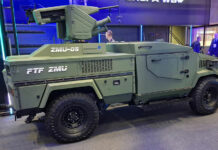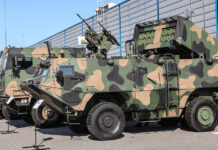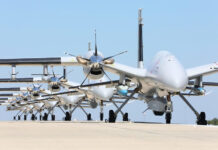The new loitering munition developed for the British Army was flown for the first time on the 30th April. With this milestone the Fire Shadow Loitering Munition completing a rapid development demonstrator program lasting just 15 months. Following the successful demonstration the program is expected to follow into the assessment phase in 2008.
Team LM began design work on the new Fire Shadow weapon system in January 2007. The weapon is being presented as a solution for the UK ground forces’ requirement for a low cost, all-weather, 24 hour capability to carry out precision attacks against surface targets which may be difficult to engage and time sensitive. Fire Shadow is expected to operate at a range of more than 100km and achieve a sub-metric CEP (Circular Error Probability). The weapon will be autonomous but retain the man in the loop capability. The loitering weapon will be targeted by ISTAR assets such as Watchkeeper and will be compatible with other battlefield systems. The LM will loiter in the target area for around 10 hours and will be particularly effective in complex and urban environments.
The successful first flight represents a key milestone towards the radically reduced delivery timescale of a new weapon system capable of engaging fixed and moving targets at depth in a complex battlefield environment that is relevant to current operations. The Loitering Munition concept is part of the Army’s future Indirect Fire Precision Attack (IFPA) program worth in excess of £500 Million.
The firing demonstrated included launch, separation, flight and terminal maneuver of the innovative design concept incorporating a forward swept wing. Following the boosted launch and problem-free separation, the munition climbed to altitude and flew a pre-planned flight path. After completing this sequence the munition then executed a terminal dive incorporating a high-g manoeuvre to represent a simulated target engagement. Throughout the flight trial, onboard video imagery and position data was transmitted from the munition via a datalink and successfully received and displayed in the ground station at the Aberporth range.
lead by MBDA Team LM comprises Blue Bear Systems Research, Cranfield Aerospace, Cranfield University, Lockheed Martin UK INSYS, Marshalls SV, Meggitt, QinetiQ, Roxel, Selex SAS, Thales UK, Ultra Electronics and VEGA.
















